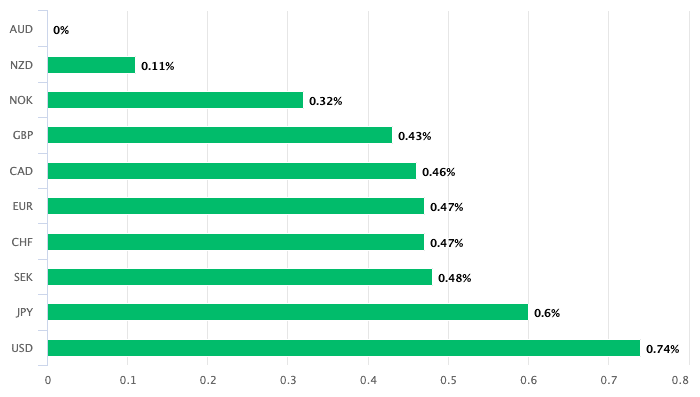Australian Dollar Tops the Leaderboard Following RBA's Taper Decision
- Written by: Gary Howes

Above: File image of Governor Philip Lowe. Photo: O'Neill Photographics/Goldman Sachs. Source: RBA on Flickr, reproduced with permission from the RBA press office.
- GBP/AUD reference rates at publication:
- Spot: 1.8300
- Bank transfer rates (indicative guide): 1.7660-1.7790
- Money transfer specialist rates (indicative): 1.8143-1.8180
- More information on securing specialist rates, here
- Set up an exchange rate alert, here
The Australian Dollar was the best performing major currency on the day the Reserve Bank of Australia (RBA) said it would start slowing down its asset purchase programme in a nod to the economy's ongoing strength.
The Australian Dollar advanced against the Euro, Pound, U.S. Dollar and others after the RBA said it would reduce the amount of Australian government bonds it purchases as part of its quantitative easing plan.
The RBA had been buying A$5BN worth of bonds every week but at Tuesday's announcement said it would reduce this to A$4BN, effective until November 11.
The move is a signal to the FX market that the RBA is now heading to the exit of its extraordinary stimulus programme which has been credited by analysts as having kept the Australian Dollar's value subdued.
"These policies help lower lending rates in the economy. They also help to produce a weaker Australian dollar than otherwise would be the case," says Besa Deda, Chief Economist at St. George Bank in Sydney.
That these programmes are being wound down over coming months is therefore ultimately supportive of the Aussie Dollar:

The Pound-to-Australian Dollar exchange rate fell by 0.40% to trade at 1.8295, the Australian-to-U.S. Dollar exchange rate rose 0.80% to trade at 0.7592.
The emergence of new Covid-19 cases in Australia and subsequent lockdowns was one area of uncertainty that might have triggered some caution at the RBA, however the Bank looks happy to look through the near-term noise posed by these outbreaks.
"One near-term uncertainty is the effect of the recent virus outbreaks and the lockdowns. But the experience to date has been that once outbreaks are contained and restrictions are eased, the economy bounces back quickly," said Governor Philip Lowe in a statement.
Indeed, in a statement the RBA noted the economy to be in a strong position:
"The unemployment rate declined further to 5.1 per cent in May and more Australians have jobs than before the pandemic."
The RBA also welcomed the decline in underemployment and noted labour force participation is around record highs.
On the back of this strength the RBA opted to 'taper' its quantitative easing programme.
"The Board is responding to the stronger-than-expected economic recovery and the improved outlook by adjusting the weekly amount purchased," said Lowe.
{wbamp-hide start} {wbamp-hide end}{wbamp-show start}{wbamp-show end}
The RBA will now move from a policy of fixing the full target level of bond purchases under its quantitative easing programme to adopting a flexible week-by-week approach.
This will allow the RBA to exit its quantitative easing programme when required, which is what the market expected.
What the market did not expect however - and this is seen to be a source of support for the Aussie Dollar - is the decision to imminently reduce the weekly bond purchase amount from A$5BN to A$4BN.
"The policy is a tighter approach than we had expected," says Bill Evans, Chief Economist at Westpac.
The RBA therefore will effectively buy up to A$40BN worth of bonds in its quantitative easing programme, which is less than the market had expected.
The RBA meanwhile opted to keep targeting the April 2024 bond under its Yield Curve Control (YCC) programme - which is a constituent of the asset purchase programme.
There had been a risk that the RBA started buying the November 2024 bond, which some said would have been a dovish signal that might have triggered Aussie Dollar weakness.
"The decision to not extend the Yield Curve Target program to the November 2024 bonds is a decision to further tighten policy," says Evans.
Looking ahead, the RBA is tipped by Westpac to make an exit from asset purchases through 2022.
Westpac expect that the U.S. Federal Reserve will announce its intention to begin tapering its bond purchases in September with a lift off date in early January carrying through to mid 2022.
"The FED’s actions, once begun, will give the RBA cover should it decide to curtail its purchases even earlier than our expectation of around mid 2022," says Evans.
Westpac says the July statement from the RBA was more hawkish than they had anticipated and is consistent with their view that the first rate hike will come in March 2023 which is much earlier than the RBA's current "central scenario" for a first rate rise of 2024.




